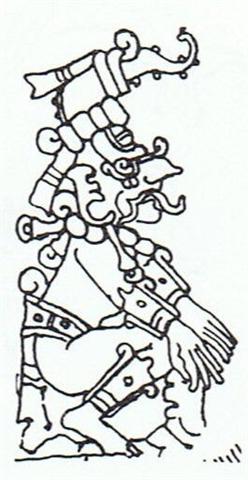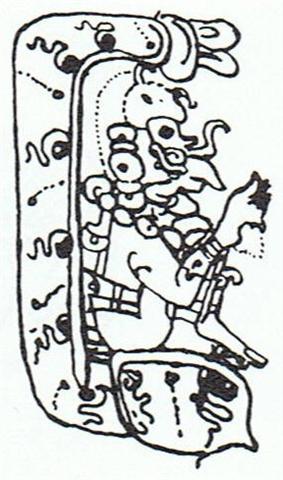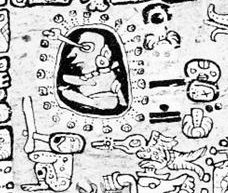1. When Sun goes away the sense of sound grows in importance, because the eyes can no longer work properly. In contrast, the Rain God as a child (in picture number 10) should be at the beginning of the season when the change goes in the other direction, from night, sound, and ears to day, light, and eyes. But he is not yet looking down on us:
Although he is showing his fingers in front, 4 on his left hand (probably representing autumn, the night side) and 4 + thumb on his right hand (spring). His right hand is in disorder, with fingers spreading out and with thumb on the wrong side. Spring is a season of disorder, because everything happens so quickly and growth is spreading out in all directions. The thumb of his left hand cannot be seen and presumably it illustrates how Sun has only 1 'face' - his '2nd face' is buried in the ground at midsummer:
In his childish state, in his 10st 'station', (when he is on his way up again from the 'underground', 'returning from the dead'), we can therefore see only 9 fingers, and Rain God at station 9 evidently represents his final station. Sure enough, here both his thumbs are drawn very clearly:
His right hand is as before in disorder, but now with its back side hidden from view, and likewise are the tips of his fingers - excepting those of his thumbs - not visible. When OgotemmÍli explained the function of drums he said that the Nummo had created the armpit drum (apparently corresponding to Moon because there were 2 of them), and he also stated that the Nummo had no external ears: ... Cupping his two hands behind his ears, OgotemmÍli explained that the spirit had no external ears but only auditory holes. 'His hands serve for ears,' he said; 'to enable him to hear he always holds them on each side of his head. To tap the drum is to tap the Nummo's palms, to tap, that is, his ears.' Moon rules 'the night', and hands represent number 5, which in turn probably indicates the number of fingers (periods) to be counted in the season when Sun is present, viz. 'daytime'. Thus the Nummo must use his hands in order to hear properly. Because the important characteristic of ears is to be the opposite of fingers, to be holes. A hole leads sound from the outside to the inside of the head. And if a hole is necessary for sound reaching into the head, then the opposite of a hole, a finger, should be connected with the opposite of sound, viz. light (which arrives from fires). But instead of going in through the eyes, light should go in the opposite direction. This is clearly illustrated in the picture of the Mayan astronomer who is reaching out with his eye to the 24th star:
In order to hear properly it is necessary to be able to discern and eyes are much better at that task than ears. Cupping (») your hands behind your ears should therefore make thing easier. |



